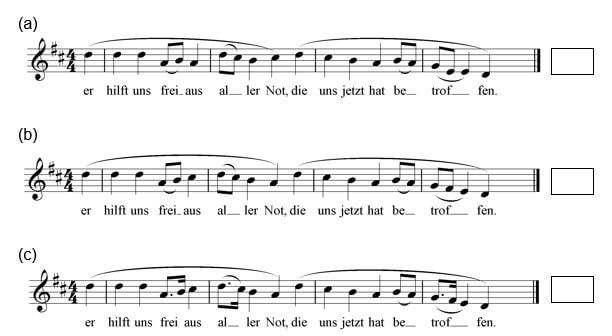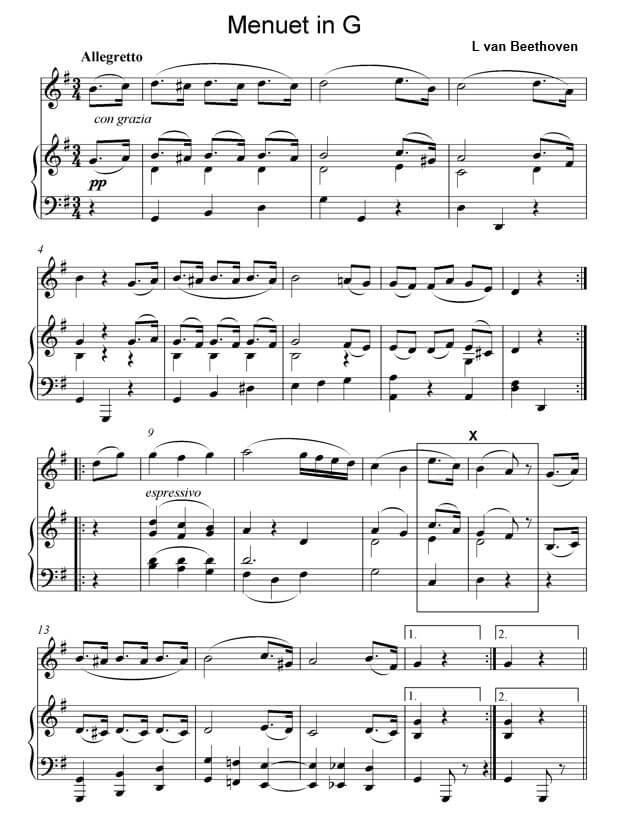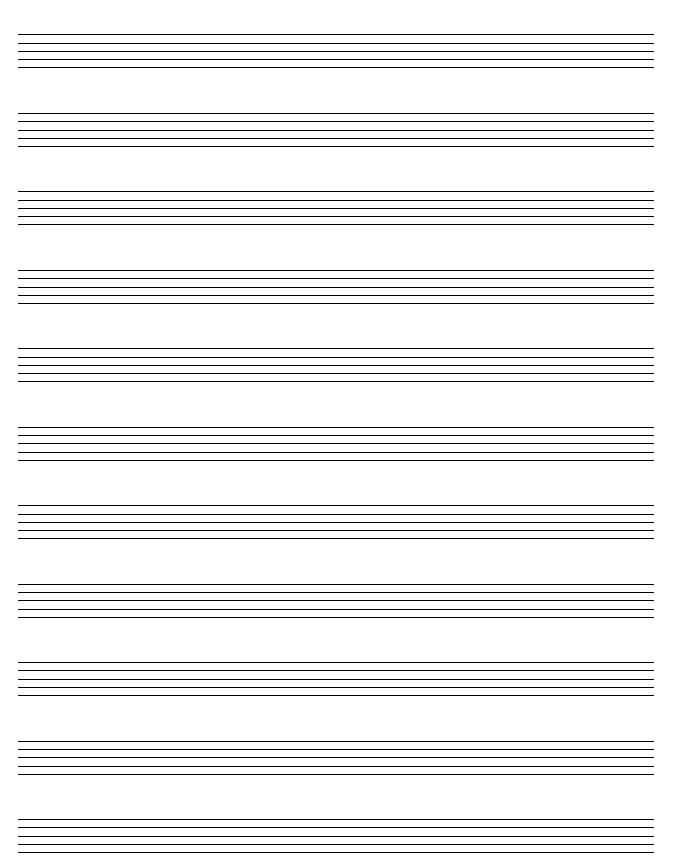MUSIC PAPER 2 GRADE 12 QUESTIONS - NSC PAST PAPERS AND MEMOS FEBRUARY/MARCH 2018
Share via Whatsapp Join our WhatsApp Group Join our Telegram GroupMUSIC
PAPER 2
GRADE 12
NSC PAST PAPERS AND MEMOS
FEBRUARY/MARCH 2018
INSTRUCTIONS AND INFORMATION
- This question paper consists of THREE sections:
SECTION A: Aural (10)
SECTION B: Recognition (12)
SECTION C: Form (8) - QUESTION 1, QUESTION 2, QUESTION 3 and QUESTION 7 are COMPULSORY.
- Answer QUESTION 4 (Western Art Music (WAM)) OR QUESTION 5 (JAZZ) OR QUESTION 6 (Indigenous African Music (IAM)).
- Write ALL your answers on this question paper. Use a pencil for music notation and blue or black ink for the other answers.
- This examination will be done while candidates are listening to a CD.
- The music teacher of the centre must conduct the examination in the presence of the invigilator.
- The last page of this question paper is manuscript paper intended for rough work. The candidate MUST NOT remove this page.
- Candidates may NOT have access to any musical instrument for the duration of this examination.
- Candidates must take note of the mark allocation of each question in order to provide enough information in their answer.
- Write neatly and legibly.
INSTRUCTIONS TO THE PERSON OPERATING THE SOUND EQUIPMENT
- The instructions for the music teacher appear in frames.
- Each music extract (track) must be played the number of times specified in the question paper.
- Allow adequate time between tracks to give candidates time to think and write their answers before playing the next track.
- The number of the track must be announced clearly each time before it is played.
- If a school offers more than one stream (Western Art Music (WAM)), jazz, Indigenous African Music (IAM)), the following guidelines must be followed:
- Each stream must do the examination in a separate venue.
- Each venue must be equipped with suitable sound equipment.
- Each venue must have its own CD with music extracts.
- An invigilator must be present in each venue.
- The tracks have to be played as follows:
- WAM candidates: Tracks 1–24 and Track 37–39
- JAZZ candidates: Tracks 1–12, Tracks 25–30 and Track 37–39
- IAM candidates: Tracks 1–12 and Tracks 31–39
- A battery-powered CD player must be available in case of a power failure.
SUMMARY OF MARKS
SECTION A: AURAL | TOTAL |
QUESTION 1 (COMPULSORY) | 5 |
QUESTION 2 (COMPULSORY) | 5 |
SUBTOTAL | 10 |
SECTION B: RECOGNITION | TOTAL |
QUESTION 3 (COMPULSORY) | 4 |
QUESTION 4 (WAM) OR | 8 |
QUESTION 5 (JAZZ) OR | 8 |
QUESTION 6 (IAM) | 8 |
SUBTOTAL | 12 |
SECTION C: FORM | TOTAL |
QUESTION 7 (COMPULSORY) | 8 |
SUBTOTAL | 8 |
| GRAND TOTAL | 30 |
QUESTIONS
SECTION A: AURAL
QUESTION 1
Play Track 1 TWICE in succession. |
1.1 Listen to the melodic and rhythmic phrase. Notate the rhythm of the missing notes in bars 2–3 below. (2)
(2)
Play Track 1 TWICE again. Pause for 30 seconds in between. |
Play Track 2 THREE times in succession. |
1.2 Listen to the extract from the Chorale Ein' feste Burg by JS Bach. Which ONE of the melodies (a), (b) or (c) corresponds with the music that you hear? Make a cross (X) in the appropriate block.  (1)
(1)
Play Track 3 ONCE. |
1.3 With which of the textures below do you associate this extract? Make a cross (X) in TWO appropriate blocks. (2)
Monophony | Polyphony | Homophony | Call and response |
[5]
QUESTION 2
Play Track 4 ONCE to provide a general overview. |
Listen to the extract from Minuetto Scherzando by A Scarlatti and answer the questions that follow.
Play Track 5 TWICE. |
2.1 Listen to bars 1–4. Name the interval formed between G and the missing note at 2.1, for example Major 3rd.
______________________________________ (1)
Play Track 6 TWICE. |
2.2 Listen to bars 5–8. Name the non-chordal note formed at 2.2, for example Passing note.
______________________________________ (1)
Play Track 7 THREE times. |
2.3 The notation of bar 3 was omitted from the score at 2.3. Fill in the missing pitches and note values that correspond with the melody that you hear. (3)
[5]
TOTAL SECTION A: 10
SECTION B: RECOGNITION OF MUSIC CONCEPTS
QUESTION 3: GENERAL LISTENING (COMPULSORY)
Study the items in COLUMN A in QUESTIONS 3.1–3.3 for two minutes.
Play Track 8 TWICE. |
3.1 Indicate TWO items in COLUMN A that relate to the music that you hear.
Make a cross (X) in TWO appropriate blocks. (2)
COLUMN A | Track 8 |
Female voices only |
|
Change of key |
|
A cappella |
|
Minor |
|
Repetition |
|
Instrumental |
|
Play Track 9 TWICE. |
3.2 Indicate TWO items in COLUMN A that relate to the music that you hear.
Make a cross (X) in TWO appropriate blocks. (2)
COLUMN A | Track 9 |
A cappella |
|
Change of key |
|
Marimba |
|
Trombone |
|
Saxophone |
|
Idiophones |
|
Play Track 10 TWICE. |
3.3 Indicate TWO items in COLUMN A that relate to the music that you hear.
Make a cross (X) in TWO appropriate blocks. (2)
COLUMN A | Track 10 |
Major |
|
Triple time |
|
Ostinato |
|
Quadruple time |
|
Adagio |
|
Minor |
|
3.4 Listen to the following TWO extracts and answer the questions that follow.
Play Track 11 ONCE. |
3.4.1 With which ONE of the following would you associate this extract?
Make a cross (X) in the appropriate block. (1)
March | Waltz | Tango | Hip-Hop |
Play Track 12 ONCE. |
3.4.2 With which ONE of the following would you associate this extract?
Make a cross (X) in the appropriate block. (1)
Glockenspiel | Bell | Harp | Harpsichord |
(8 ÷ 2) [4]
Answer QUESTION 4 (WAM) OR QUESTION 5 (JAZZ) OR QUESTION 6 (IAM).
QUESTION 4: WAM
4.1 Listen to the extracts from The Magic Flute by Mozart and answer the questions that follow.
Play Tracks 13, 14 and 15 ONCE each. |
4.1.1 Identify the most suitable term to describe the character of the extracts. Choose from the list below. Make a cross (X) in the appropriate block (3)
Term | Track 13 | Track 14 | Track 15 |
Lustig |
| ||
Semplice | |||
Subito | |||
Con fuoco | |||
Allegretto | |||
Grave |
Play Track 16 ONCE. |
4.1.2 Name the character that sings in this extract.
______________________________________ (1)
4.1.3 Name the voice type of this character.
______________________________________ (1)
4.2 Listen to the extracts and answer the questions that follow.
Play Track 17 ONCE. |
4.2.1 Identify the genre/work type of this extract, for example Concerto.
______________________________________(1)
4.2.2 Identify the composer of this extract.
_______________________________________(1)
4.2.3 What is the tonality of this extract?
______________________________________(1)
Play Track 18 ONCE. |
4.2.4 Identify the statement in COLUMN A that relates to the music that you hear. Make a cross (X) in the appropriate block. ate block. (1)
COLUMN A | Answer |
The double basses and cellos play a pedal point. | |
The double basses and cellos play tremolo. |
|
The violas and double basses play pizzicato. | |
The violas and cellos play an ostinato. |
Play Tracks 19, 20 and 21 ONCE each. |
4.2.5 Identify the woodwind instrument in EACH extract. Write the answer in the table below. (3)
TRACK | Name of instrument |
Track 19 | |
Track 20 | |
Track 21 |
Play Tracks 19, 20 and 21 ONCE more. |
4.3 Listen to the extracts and answer the questions that follow.
Play Track 22 ONCE. |
4.3.1 Name TWO compositional techniques used in this extract.
______________________________________________________________________________________________________ (2)
Play Tracks 23 and 24 TWICE in succession. |
4.3.2 Compare the melodies in the following two extracts and state ONE similarity and ONE difference.
Similarity: ___________________________________________________________________________
Difference: _________________________________________________________________________ (2) (16 ÷ 2) [8]
TOTAL SECTION B: 12
OR
QUESTION 5: JAZZ
5.1 Listen to the extract and answer the questions that follow.
Play Track 25 ONCE. |
5.1.1 Identify the South African jazz style that you hear in this extract.
______________________________________________________ (1)
5.1.2 Give TWO reasons, related to the music, to motivate your answer to QUESTION 5.1.1.
_______________________________________________________ (2)
5.2.3 Name ONE artist/band that you associate with this extract.
_______________________________________________________ (1)
5.2 Listen to the extracts and answer the questions that follow.
Play Track 26 ONCE. |
5.2.1 Identify the South African music style that you hear in this extract.
_______________________________________________________(1)
5.2.2 Name an artist that you associate with your answer to QUESTION 5.2.1.
_______________________________________________________ (1)
5.2.3 Name the compositional technique used in the piano part.
_______________________________________________________ (1)
5.2.4 Identify ONE idiophone that you hear in this extract.
_______________________________________________________(1)
Play Track 27 ONCE. |
5.2.5 Describe the use of rhythm that you hear in the piano part.
______________________________________________________________________________________________________________(2)
5.3 Listen to the extract and answer the questions that follow.
Play Track 28 TWICE. |
5.3.1 Name an artist that you associate with this extract.
_____________________________________________________(1)
5.3.2 Describe the music style you hear in this extract by referring to THREE musical features.
______________________________________________________________________________________________________________ (3)
Play Track 29 and Track 30 TWICE in succession. |
5.4 Listen to the two extracts and identify TWO differences with regards to the beat and instruments that drive the rhythm. (4)
Feature | Track 29 | Track 30 |
Beat |
| |
Instruments |
(16 ÷ 2) [8]
TOTAL SECTION B: 12
OR
QUESTION 6: IAM
6.1 Listen to the extracts and answer the questions that follow.
Play Track 31 ONCE. |
6.1.1 Identify the South African style of music heard in this extract
_______________________________________(1)
6.1.2 Give THREE reasons, related to the music, to motivate your answer to QUESTION 6.1.1.
______________________________________________________ (3)
Play Track 32 ONCE. |
6.1.3 Give TWO features that make this extract different from the original style mentioned in QUESTION 6.1.1.
______________________________________________________ (2)
6.1.4 Name an artist associated with this extract.
______________________________________________________ (1)
6.2 Listen to the extract and answer the question that follows.
Play Track 33 ONCE. |
6.2.1 Describe the use of rhythm between the clapping and the drums.
___________________________________________________________________ (2)
6.2.2 Identify the idiophone that you hear.
______________________________________________________ (1)
6.3 Identify TWO differences in the extracts that you hear with regard to the relevant style and the use of drums. (4)
Play Tracks 34 and 35 TWICE in succession. |
Criteria | Track 34 | Track 35 |
Style |
| |
Drums |
6.4 Listen to the extract and answer the questions that follow.
Play Track 36 ONCE. |
6.4.1 Identify the South African music style that you hear in this extract.
____________________________________________(1)
6.4.2 Name an artist/band that you associate with this extract.
____________________________________________ (1)
(16 ÷ 2) [8]
TOTAL SECTION B: 12
SECTION C: FORM
QUESTION 7
Read and study the questions for ONE minute.
Play Track 37 ONCE to provide an overview. |
Listen to the extract from Minuet in G by Beethoven while you study the score.
Play Track 37 again. |
7.1 Name the main key of this work.
____________________________________________(1)
7.2 What is the form of this piece?
___________________________________________ (1)
7.3 Motivate your answer to QUESTION 7.2 by giving a schematic layout of the form of this piece. Use the table below.(2)
SeCTION | Bar numbers |
7.4 To which key does the piece modulate in bars 7–8?
________________________________________________ (1)
7.5 What is the function of the A# note in bar 5?
________________________________________________ (1)
Play Track 38 again. |
7.6 Name the cadence formed at X.
________________________________________________ (1)
7.7 Give the meaning of allegretto.
________________________________________________ (1)
Play Track 39 for a general overview. |
TOTAL SECTION C: 8
GRAND TOTAL: 30
